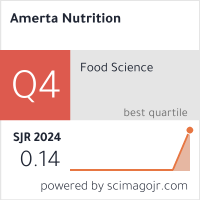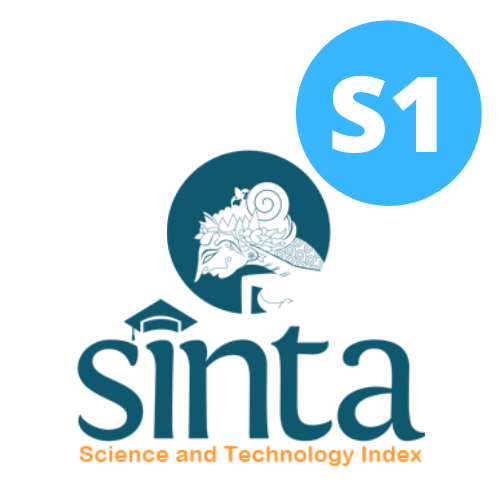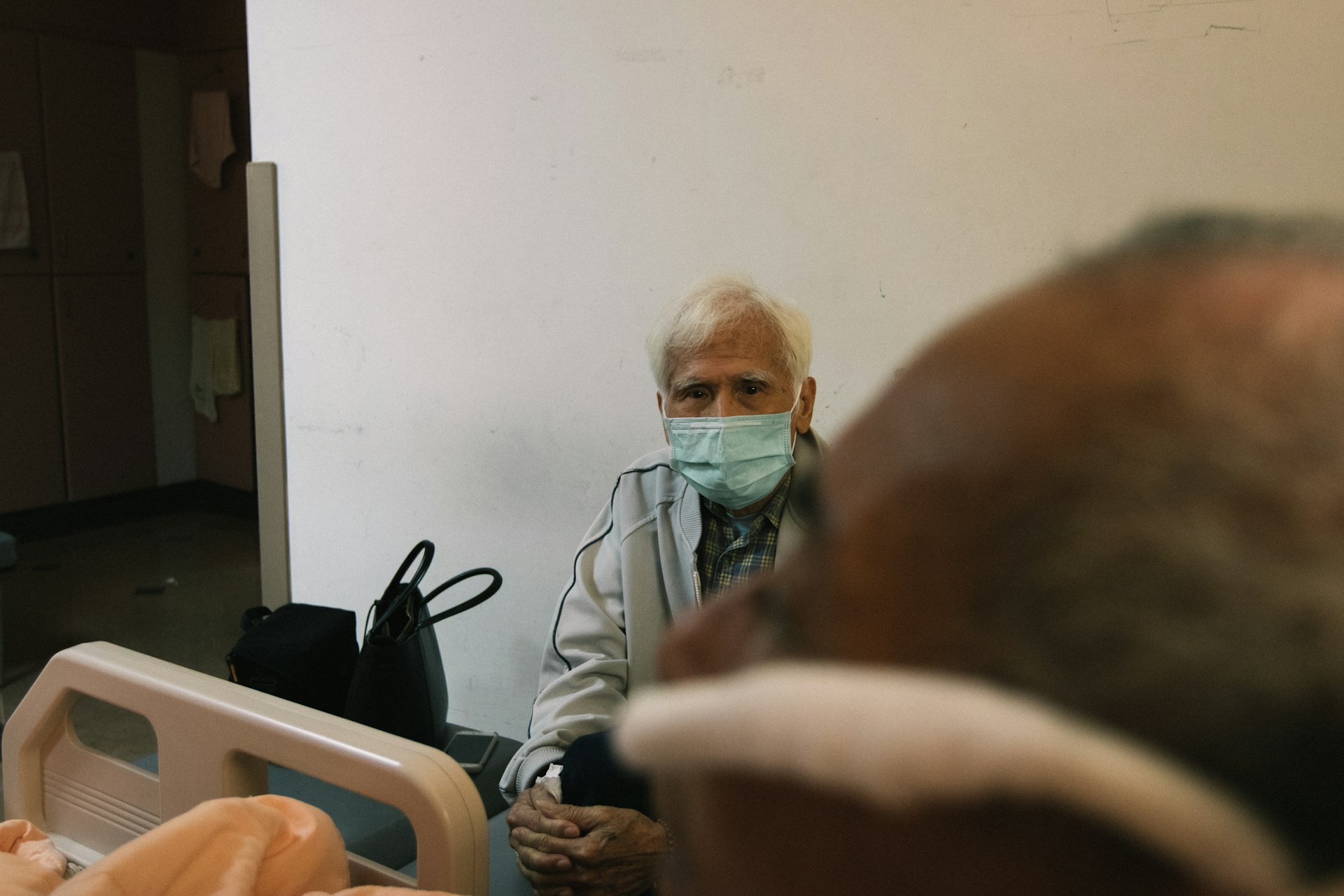Indirect Determinant Effects of Stunting with Toddler Stunting Incident in Papua New Guinea in 2018
Pengaruh Determinan Tidak Langsung Stunting dengan Kejadian Stunting Balita di Papua New Guinea Tahun 2018

Downloads
Background: Papua New Guinea has a significant problem with stunting, with a prevalence rate of 46.5% in 2018.
Objectives: This study aimed to analyze the effect of various factors on stunting in Papua New Guinea in 2018. These factors include characteristics of the child (gender, age, and ownership of health insurance) and household environmental factors such as the mother's education level, number of toddlers in the household, drinking water sources, and availability of restrooms.
Methods: This study employed a cross-sectional research design using secondary data from "The Demographic and Health Surveys (DHS) in Papua New Guinea in 2018." The variables of interest were extracted and subjected to data cleaning procedures, resulting in a final sample size of 744 toddler data points available for analysis. The chi-square test and logistic regression were employed for statistical analysis.
Results: The study revealed that mothers of toddlers who had never received any formal education were more likely to have toddlers who experienced stunting. The statistical analysis showed a significant association between the lack of maternal education and toddler stunting (p-value=0.012; odds ratio=1.488; 95% confidence interval [1.092; 2.028]). Additionally, toddlers in the age group of 24-59 months were found to be at a higher risk of experiencing stunting. The statistical analysis indicated a strong association between this age group and toddler stunting (p-value<0.001; odds ratio=1.770; 95% confidence interval [1.301; 2.408]).
Conclusions: The approach to addressing stunting in toddlers aged 24-59 months emphasizes the implementation of targeted and responsive interventions, with particular emphasis on the significance of investing in the education of toddler mothers in Papua New Guinea. However, in terms of prevention, it is crucial to administer the intervention before the toddler reaches the age of 24-59 months, as stunting is a visible result of long-term malnutrition.
INTRODUCTION
The second objective of the Sustainable Development Goals (SDGs) is to eradicate all types of malnutrition, including stunting1. Children who experience stunting often exhibit compromised cognitive, physical, and metabolic growth, which can subsequently contribute to the development of cardiovascular disease in adulthood2. Furthermore, stunting can result in diminished cognitive capacity and academic performance and decreased economic output in adulthood2.
Stunting is not an abrupt occurrence; however, rather a gradual manifestation of malnutrition that develops over an extended period (chronic)3. Stunting is a result of growth and development issues that children face owing to malnutrition, frequent illnesses, and insufficient psychosocial stimulation4. Children are classified as stunted if their height-for-age falls more than two standard deviations below the World Health Organization (WHO) Child Growth Standards.
As per the World Health Organization (WHO) report from 2023, the worldwide occurrence of stunting is projected to reach 22.3%6in 2022. While the drop has been gradual over the past five years, it has only been at a rate of 0.2% per year6. Over the same time frame, nations in the Oceania region, excluding Australia and New Zealand, have had a yearly rise in frequency of about 0.3%. In the year 2022, the value will be 44.0%6. The stunting prevalence in Papua New Guinea in 2018 was 46.5%7.
As stated in the WHO conceptual framework, stunting is caused by proxy determinants and contextual determinants. Proxy determinants refer to immediate causes or factors at the individual and family level that affect children's first stages of hindered growth and development. Contextual factors refer to determinants from the community, society, or multi-sectoral institutions with policies addressing proxy causes8. The variables that contribute to stunting include many aspects of the family and home environment, and factors related to breastfeeding, complementary feeding, and the health state of toddlers3.
Pham et al. (2021)7conducted a study in five provinces of Papua New Guinea to determine the prevalence of wasting and stunting. In addition, they analyzed various socio-economic and maternal demographic factors that contribute to the occurrence of wasting and stunting. The study utilized secondary data collected from the Comprehensive Health and Epidemiology Surveillance System (CHESS) of the Papua New Guinea Institute of Medical Research (IMR) during July-December 2018. The December 2018 report from the Comprehensive Health and Epidemiology Surveillance System (CHESS) of the Papua New Guinea Institute of Medical Research (IMR) revealed that no significant socio-economic and maternal demographic factors affect the incidence of stunting, except for the age of toddlers. Specifically, toddlers aged 36-47 months are 1.44 times more likely to experience stunting compared to toddlers aged 48-59 months in Papua New Guinea.7examined many factors influencing socio-economic and maternal demographics. These factors include rural/urban location, household welfare quintile, food insecurity, marital status of mothers under five, education level of mothers under five, age of mothers under five, and gender.
This study seeks to analyze the factors that contribute to the occurrence of stunting in Papua New Guinea. It will use various data sources from the same year to examine the influence of factors related to children (such as gender, age, and health insurance ownership) and household environmental factors (including the education level of mothers with children under five, the number of children under five in the household, and the quality of drinking water sources and latrines) on stunting incidence. The analysis will be based on the 2018 Demographic and Health Surveys (DHS) data. The selection of factors was examined by considering the theoretical correlation between variables and the comprehensiveness of the data provided by the DHS.
METHODS
This study employs a cross-sectional research methodology and does secondary data analysis using the data from the Demographic and Health Surveys Programme (DHS) conducted by the United States Agency for International Development (USAID) in Papua New Guinea in 2018.
The 2018 DHS programme yielded a total of 2,337 target data points. Extraction and cleaning were carried out during the data processing phase. The data to be analyzed must meet the inclusion requirements, which require the data to be complete and aligned with the studied variables. A total of 97 toddlers died, resulting in a lack of data. Out of the remaining 2,240 data points, only 931 had anthropometric measurements. The other data points were eliminated due to missing or inadequate information for the analyzed variables. A total of 744 toddler data were collected.
The study focused on the incidence of stunting as the dependent variable. Stunting was defined as having a height or length for age more than—two standard deviations below the WHO child growth criteria median. The variables examined were the gender and age of toddlers, their mother's education level, the number of toddlers in the family, whether they had health insurance, and the conditions of their drinking water sources and latrine sanitation.
The analysis employed univariable descriptive statistical analysis, explicitly calculating the frequency and percentage of each variable. Next, we proceeded with bivariable analysis, explicitly using cross-tabulation, and applied either the chi-square test or Fisher's Exact test to examine the relationship between each independent variable and the occurrence of stunting. We set a significance level of (p<0.25) to identify potential predictor factors. The candidate predictor variables will undergo multiple logistic regression tests using the backward Wald technique. Categorical covariates will be evaluated using the reference category first. The significance
Department of Economic and Social Affairs Sustainable Development. Goals 2 End hunger, achieve food security and improved nutrition and promote sustainable agriculture. https://sdgs.un.org/goals/goal2#targets_and_indicators (2024).
Bank, A. D. 2020 Global Nutrition Report: Country Nutrition Profiles. The burden of malnutrition at a glance (2021).
Menteri Kesehatan RI. Keputusan Menteri Kesehatan Republik Indonesia Nomor HK.01.07/MENKES/1928/2022 Tentang Pedoman Nasional Pelayanan Kedokteran Tata Laksana Stunting. Kementerian Kesehatan Republik Indonesia (2022).
WHO. Stunting in a Nutshell. Https://www.who.Int/News/Item/19-11-2015-Stunting-in-a-Nutshell https://www.who.int/news/item/19-11-2015-stunting-in-a-nutshell (2015).
De Onis, M. WHO Child Growth Standards based on length/height, weight and age. Acta Paediatr. Int. J. Paediatr. 95, (2006).
WHO. Stunting prevalence among children under 5 years of age (%) (model-based estimates). World Health Organization https://www.who.int/data/gho/data/indicators/indicator-details/GHO/gho-jme-stunting-prevalence (2023).
Pham, B. N., Silas, V. D., Okely, A. D. & Pomat, W. Measuring Wasting and Stunting Prevalence Among Children Under 5 Years of Age and Associated Risk Factors in Papua New Guinea: New Evidence From the Comprehensive Health and Epidemiological Surveillance System. Front. Nutr. 8, (2021).
Stewart, C. P., Iannotti, L., Dewey, K. G., Michaelsen, K. F. & Onyango, A. W. Contextualising complementary feeding in a broader framework for stunting prevention. Matern. Child Nutr. 9, (2013).
WHO. WHO Child Growth Standards: Length/Height-for-Age, Weight-for-Age, Weight-for-Length, Weight-for- Height and Body Mass Index-Forage: Methods and Development. World Health Organisation (2006).
NSO PNG and ICF. National Statistical Office (NSO) [Papua New Guinea] and ICF. Papua New Guinea Demographic and Health Survey 2016–18. (2019).
Hou, X. H. Stagnant stunting rate despite rapid economic growth in Papua New Guinea: factors correlated with malnutrition among children under five. Policy Res. Work. Pap. - World Bank (2015).
Global Nurition Report. Country Nutrition Profiles: Papua New Guinea, The Burden of Malnutrition at a Glance. https://globalnutritionreport.org/resources/nutrition-profiles/oceania/melanesia/papua-new-guinea/ (2022).
Toma, T. M., Andargie, K. T., Alula, R. A., Kebede, B. M. & Gujo, M. M. Factors associated with wasting and stunting among children aged 06–59 months in South Ari District, Southern Ethiopia: a community-based cross-sectional study. BMC Nutr. 9, (2023).
Danso, F. & Appiah, M. A. Prevalence and associated factors influencing stunting and wasting among children aged 1 to 5 years in Nkwanta South Municipality, Ghana. Nutrition (2023) doi:10.1016/j.nut.2023.111996.
Permenkes RI. Peraturan Menteri Kesehatan Tentang Standar Antropometri Anak. Kemenkes RI vol. 2 (2020).
Tafesse, T., Yoseph, A., Mayiso, K. & Gari, T. Factors associated with stunting among children aged 6–59 months in Bensa District, Sidama Region, South Ethiopia: unmatched case-control study. BMC Pediatr. 21, (2021).
Odei Obeng-Amoako, G. A. et al. Factors associated with concurrent wasting and stunting among children 6–59 months in Karamoja, Uganda. Matern. Child Nutr. 17, (2021).
Fauziyah, N., Africia, F. & Dinastiti, V. B. Hubungan Tingkat Pendidikan Dan Jumlah Anak Dengan Pola Asuh Dalam Kejadian Stunting. J. Penelit. KEPERAWATAN 9, (2023).
Balitbangkes RI. Laporan Riskesdas 2018 Nasional.pdf. Lembaga Penerbit Balitbangkes at (2018).
Lobo, W. I., Talahatu, A. H. & Riwu, R. R. Faktor Penentu Kejadian Stunting pada Anak Balita di Wilayah Kerja Puskesmas Alak Kota Kupang. Media Kesehat. Masy. 1, (2019).
Cameron, L. et al. Childhood stunting and cognitive effects of water and sanitation in Indonesia. Econ. Hum. Biol. 40, (2021).
Quamme, S. H. & Iversen, P. O. Prevalence of child stunting in Sub-Saharan Africa and its risk factors. Clinical Nutrition Open Science vol. 42 at https://doi.org/10.1016/j.nutos.2022.01.009 (2022).
Kombih, M. F. Determinan Stunting Anak Usia 0-23 Bulan di Provinsi Jawa Timur Bagian Utara Berdasarkan Data SSGI Tahun 2021. (Airlangga University, Surabaya, 2023).
Sahiledengle, B. et al. Concurrent wasting and stunting among under-five children in the context of Ethiopia: A generalised mixed-effects modelling. Matern. Child Nutr. 19, (2023).
Abadi et al. Ilmu Gizi. (Pustaka Aksara, Surabaya, 2023).
Desma Simbolon. Pengaruh Kepemilikan Jaminan Kesehatan Masyarakat Miskin Terhadap Status Kelahiran Dan Kejadian Stunting Pada Baduta Indonesia (Analisis Data IFLS 1993-2007). J. Kebijak. Kesehat. Indones. 03, (2014).
Pertiwi, F. D., Prastia, T. N. & Nasution, A. Hubungan Faktor Sosial Ekonomi dan Riwayat Pemberian ASI Eksklusif dengan Kejadian Stunting pada Balita. J. Ilmu Kesehat. Masy. 10, (2021).
Yuliawati, E. Inisisasi Menyusu Dini, Keanekaragaman Makanan Dan Jaminan Kesehatan Terhadap Kejadian Stunting Pada Anak Usia 24-59 Bulan Di Kabupaten Kepulauan Mentawai Sumatera Barat Tahun2019. Hum. Care J. 4, (2019).
Harsa, I. M. S. The Relationship Between Clean Water Sources And The Incidence Of Diarrhea In Kampung Baru Resident At Ngagelrejo Wonokromo Surabaya. J. Agromedicine Med. Sci. 5, (2019).
Damanik, N. S., Simanjuntak, P. & Febrina Sinaga, P. N. Pengaruh Pijat Bayi Terhadap Peningkatan Berat Badan Pada Bayi Umur 0-6 Bulan. Indones. Heal. Issue 1, (2022).
Aryu Candra. Epidemiologi Stunting. (Universitas Diponegoro, 2020).
Brou, A. M. et al. Urban–rural differences in the relationship between stunting, preschool attendance, home learning support, and school readiness: A study in Côte d’Ivoire. Front. Public Heal. 10, (2023).
Madinar. Fulfilment of minimum acceptable diet (MAD), short birth length and family income level are associated with stunting in children aged 6-23 months in Central Jakarta. Malays. J. Nutr. 27, (2021).
Gunardi, H. Optimalisasi 1000 Hari Pertama Kehidupan: Nutrisi, Kasih Sayang, Stimulasi, dan Imunisasi Merupakan Langkah Awal Mewujudkan Generasi Penerus yang Unggul. eJournal Kedokt. Indones. 9, (2021).
Supardi, N., Sinaga, T. ., Hasanah, F. L. . & dkk. Gizi Pada Bayi Dan Balita. (Yayasan Kita Menulis, Medan, 2023).
Menteri Kesehatan RI. Peraturan Menteri Kesehatan Republik Indonesia Nomor 28 Tahun 2019 Tentang Angka Kecukupan Gizi. PMK (2019).
Kementerian Kesehatan RI. Pedoman Pelaksanaan Stimulasi, Deteksi, Dan Intervensi Dini Tumbuh Kembang Anak Di Tingkat Pelayanan Kesehatan Dasar. Kementerian Kesehatan Republik Indonesia (2022). doi:10.1017/CBO9781107415324.004.
Fufa, D. A. Determinants of stunting in children under five years in dibate district of Ethiopia: A case-control study. Hum. Nutr. Metab. 30, (2022).
Copyright (c) 2024 Amerta Nutrition

This work is licensed under a Creative Commons Attribution-ShareAlike 4.0 International License.
AMERTA NUTR by Unair is licensed under a Creative Commons Attribution-ShareAlike 4.0 International License.
1. The journal allows the author to hold the copyright of the article without restrictions.
2. The journal allows the author(s) to retain publishing rights without restrictions
3. The legal formal aspect of journal publication accessibility refers to Creative Commons Attribution Share-Alike (CC BY-SA).
4. The Creative Commons Attribution Share-Alike (CC BY-SA) license allows re-distribution and re-use of a licensed work on the conditions that the creator is appropriately credited and that any derivative work is made available under "the same, similar or a compatible license”. Other than the conditions mentioned above, the editorial board is not responsible for copyright violation.












































